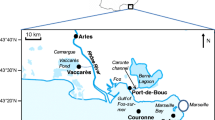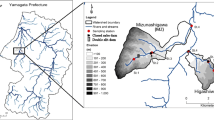Abstract
Fluorescence excitation-emission matrix (EEM) spectroscopy was used to investigate spatial and temporal variability in the optical properties of dissolved organic matter in the Arcachon Bay and its main tributaries. Seasonal effects and different trends in composition as well as in size of dissolved organic matter (DOM) were observed for samples collected from the Arcachon lagoon. We do not observe such a variability for the samples collected from the nine main tributaries of the Arcachon Bay. DOM quality was however specific for each tributary site.
Access provided by Autonomous University of Puebla. Download conference paper PDF
Similar content being viewed by others
Keywords
- Arcachon Bay
- Asymmetric flow field-flow fractionation (AF4)
- Dissolved organic matter
- Excitation-emission matrix (EEM) spectroscopy
Introduction
Dissolved organic matter (DOM) is a heterogeneous, complex mixture of compounds with wide-ranging chemical properties and diverse origins. It is well known to interact with pollutants and to affect their transport and their fate in aquatic environment and plays a vital role in the global cycling of carbon. The composition and reactivity of DOM in aquatic ecosystems are still poorly understood; however, various optical techniques are providing new insights from diverse environments (McKnight et al. 2001; Helms et al. 2008; Stedmon et al. 2011).
This study focused on tracing DOM sources and cycling in an economically important coastal area: the Arcachon Bay (South Western France).
Materials and Methods
Surface water samples were quarterly collected from the Arcachon Bay (six stations), and the nine main tributaries of the Bay were monthly sampled (Fig. 1).
The fluorescence spectra were recorded using a Fluorolog FL3-22 Jobin Yvon fluorometer equipped with double monochromators for both the excitation and emission sides. The samples were contained in a 1-cm path-length-fused silica cell (Hellma), thermostated at 20°C. The fluorescence excitation-emission matrix (EEM) spectroscopy involved scanning and recording 17 individual emission spectra (260–700 nm) at sequential 10-nm increments of excitation wavelength between 250 and 410 nm. The EEM spectra of the samples were corrected by subtracting the EEM spectra of ultrapure water. The main bands observed for natural waters are shown on Table 1.
The absorbance spectra of DOM was recorded with a Jasco V-560 spectrophotometer equipped with deuterium and tungsten iodine lamps in order to avoid inner filtering effect before fluorescence analysis (Huguet et al. 2009).
Asymmetric flow field-flow fractionation (AF4) offers new perspectives in the characterization and separation of biopolymers (Yohannes et al. 2011) and colloidal macromolecules (Alasonati et al. 2010; Guéguen and Cuss 2011). This technique allows to separate colloidal material depending on its size. Separation takes place in a channel without stationary phase. Some samples were analyzed to determine the size distribution of DOM using a Wyatt Technology Eclipse AF4 system coupled to a UV detector (Agilent) and a multi-angle laser-light-scattering detector (MALLS-DAWN TREOS Wyatt Technology).
Results and Discussion
In order to discuss the results of the fluorescence analysis of the different samples, we considered the fluorescence intensities of the main fluorescence bands (Table 1) and the ratios of these intensities (Iα’/Iα, Iβ/Iα, and Iγ/Iα). Fluorescence indices were also calculated and discussed (HIX – humification index, and BIX – biological autochthonous input index (Huguet et al. 2009)).
We observed seasonal effects and different trends in composition as well as in behavior or production of fluorescent DOM. HIX and BIX fluorescence indices showed spatial and seasonal variations of the quality of fluorescent DOM from the Arcachon Bay as shown as an example in Fig. 2 for samples collected in 2010.
There was, on the contrary, no marked seasonality for the tributaries; however, a specific fluorescent DOM type was observed for each tributary site (Fig. 2.).
DOM absorbance measurements were made for all samples. The measured absorbance at wavelength λ was converted to absorption coefficient a (m−1) according to a λ = 2.303A λ/L (A λ: absorbance, L path-length of the optical cell in meters (here 0.01 m)). The wavelength dependence of absorption coefficient was parameterized with a nonlinear exponential model according to a λ = a λ0e−S.λ. The slope parameter S was calculated over the 275–295-nm (S 275–290) and 350–400-nm (S 350–400) range, using nonlinear least squares fit procedures. Spectral slope ratio S R was calculated: S R = S 275–290 /S 350–400.
Spectral slope ratio S R distributions showed seasonal variations for the samples collected from the Arcachon Bay, as shown, for example, for “Banc d’Arguin” sample (Fig. 3a), suggesting a great variability of colored DOM molecular weight (when S R increases, MW decreases).
Even though we do not observe such a variability for the samples collected from the tributaries (“La Hume” sample as an example (Fig. 3b)), DOM was characterized by specific quality from one tributary site to another (Fig. 2). This variability in DOM quality is also well illustrated in Fig. 4, showing AF4 DOM fractionation for four tributary samples.
Conclusion
The analysis of DOM of waters from the Arcachon Bay during a 4-year survey allowed us to discriminate between various sources of colloidal organic matter and highlighted spatial and temporal variabilities of their composition and size.
References
Alasonati, E., V.I. Slaveykova, H. Gallard, J. Croué, and M.F. Benedetti. 2010. Characterization of the colloidal organic matter from the Amazonian basin by asymmetrical flow field-flow fractionation and size exclusion chromatography. Water Research 44: 223–231.
Guéguen, C., and C.W. Cuss. 2011. Characterization of aquatic dissolved organic matter by asymmetrical flow field-flow fractionation coupled to UV–Visible diode array and excitation emission matrix fluorescence. Journal of Chromatography A 1218: 4188–4198.
Helms, J.R., A. Stubbins, J.D. Ritchie, E.C. Minor, D.J. Kieber, and K. Mopper. 2008. Absorption spectral slopes and slope ratios as indicators of molecular weight, source, and photobleaching of chromophoric dissolved organic matter. Limnology and Oceanography 53(3): 955–969.
Huguet, A., L. Vacher, S. Relexans, S. Saubusse, J.M. Froidefond, and E. Parlanti. 2009. Properties of fluorescent dissolved organic matter in the Gironde Estuary. Organic Geochemistry 40: 706–719.
McKnight, D.M., E.W. Boyer, P.K. Westerhoff, P.T. Doran, T. Kulbe, and D.T. Andersen. 2001. Spectrofluorometric characterization of dissolved organic matter for indication of precursor organic material and aromaticity. Limnology and Oceanography 46: 38–48.
Stedmon, C.A., R.M.W. Amon, A.J. Rinehart, and S.A. Walker. 2011. The supply and characteristics of colored dissolved organic matter (CDOM) in the Arctic Ocean: Pan Arctic trends and differences. Marine Chemistry 124: 108–118.
Yohannes, G., M. Jussila, K. Hartonen, and M.L. Riekkola. 2011. Asymmetrical flow field-flow fractionation technique for separation and characterization of biopolymers and bioparticles. Journal of Chromatography A 1218: 4104–4116.
Acknowledgements
The Regional Council of Aquitaine (programs Ascobar and Osquar) and ANR RIPOST (ANR CES 2009) are acknowledged for their financial support. All the members involved in these projects are acknowledged for their help in sampling. This project is cofinanced by the European Union. Europe makes a commitment in Aquitaine with the European Regional Development Fund. The Vietnamese Government (Ministry of Education and Training) and the French Government (Embassy of France in Hanoi) are acknowledged for the PhD grant of Nguyen Phuong Thanh.
Author information
Authors and Affiliations
Corresponding author
Editor information
Editors and Affiliations
Rights and permissions
Copyright information
© 2013 Zhejiang University Press and Springer Science+Business Media Dordrecht
About this paper
Cite this paper
Nguyen, P.T., Cordier, MA., Ibalot, F., Parlanti, E. (2013). Optical Properties and Asymmetric Flow Field-Flow Fractionation of Dissolved Organic Matter from the Arcachon Bay (French Atlantic Coast). In: Xu, J., Wu, J., He, Y. (eds) Functions of Natural Organic Matter in Changing Environment. Springer, Dordrecht. https://doi.org/10.1007/978-94-007-5634-2_27
Download citation
DOI: https://doi.org/10.1007/978-94-007-5634-2_27
Published:
Publisher Name: Springer, Dordrecht
Print ISBN: 978-94-007-5633-5
Online ISBN: 978-94-007-5634-2
eBook Packages: Earth and Environmental ScienceEarth and Environmental Science (R0)








